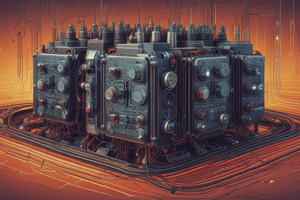Podcast
Questions and Answers
What are the two types of computer programs used to solve load flows?
What are the two types of computer programs used to solve load flows?
- Static and dynamic (correct)
- Offline and real-time
- Dynamic and real-time
- Offline and static
In the equation I Bus = YBusVBus, what does YBus represent?
In the equation I Bus = YBusVBus, what does YBus represent?
- Bus admittance matrix (correct)
- Bus voltage matrix
- Bus impedance matrix
- Bus current matrix
What are the components Generators + loads in the given equation used for?
What are the components Generators + loads in the given equation used for?
- To calculate voltage
- To calculate current
- To calculate power (correct)
- To calculate impedance
What is the purpose of specifying static load functions PLi(Vi) and QLi(Vi)?
What is the purpose of specifying static load functions PLi(Vi) and QLi(Vi)?
What type of load flow studies for system analysis are most commonly based on?
What type of load flow studies for system analysis are most commonly based on?
In the given context, what are the components of the equation I Bus = YBusVBus used for?
In the given context, what are the components of the equation I Bus = YBusVBus used for?
What is the purpose of specifying static load functions PLi(Vi) and QLi(Vi) in the context of load flows?
What is the purpose of specifying static load functions PLi(Vi) and QLi(Vi) in the context of load flows?
What type of computer programs are used to solve load flows, particularly for system analysis?
What type of computer programs are used to solve load flows, particularly for system analysis?
In the context of the given equation I Bus = YBusVBus, what does YBus represent?
In the context of the given equation I Bus = YBusVBus, what does YBus represent?
What are the components Generators + loads in the given equation used for?
What are the components Generators + loads in the given equation used for?
In the context of load flows, what is the purpose of the equation I Bus = YBusVBus?
In the context of load flows, what is the purpose of the equation I Bus = YBusVBus?
What is the significance of specifying static load functions PLi(Vi) and QLi(Vi) in the context of load flows?
What is the significance of specifying static load functions PLi(Vi) and QLi(Vi) in the context of load flows?
What does the term 'Generators + loads' represent in the given equation I Bus = YBusVBus?
What does the term 'Generators + loads' represent in the given equation I Bus = YBusVBus?
What do computer programs to solve load flows primarily focus on?
What do computer programs to solve load flows primarily focus on?
What is the main purpose of real-time load flows in the context of system analysis?
What is the main purpose of real-time load flows in the context of system analysis?
Flashcards are hidden until you start studying
Study Notes
Power System Flow and Control
- When analyzing power systems, we know neither the complex bus voltages nor the complex current injections, but rather the complex power being consumed by the load and the power being injected by the generators plus their voltage magnitudes.
Real Power Balance Equations
- The power balance equations are used to analyze power systems, which are composed of complex power injected by the generators (Si) and the power consumed by the load (Pi + jQi).
- The complex power injected by the generators (Si) is equal to the sum of the product of the voltage magnitude at bus i (Vi) and the complex conjugate of the current injection at bus i (Ii*).
- The real power balance equation is resolved into the real part (Pi) and the imaginary part (Qi), which are expressed as a function of the voltage magnitude, conductance (Gik), and susceptance (Bik).
Power Flow Requires Iterative Solution
- When solving for the complex bus voltages (V's) in the power flow, we assume we know the complex power injected by the generators (Si) and the admittance matrix (Ybus).
- The power flow equation has no closed form solution, and therefore, we must use an iterative approach to solve for the complex bus voltages.
- The iterative approach involves resolving the complex power injected by the generators into the real and imaginary parts, and then solving for the complex bus voltages using the power balance equations.
Studying That Suits You
Use AI to generate personalized quizzes and flashcards to suit your learning preferences.




